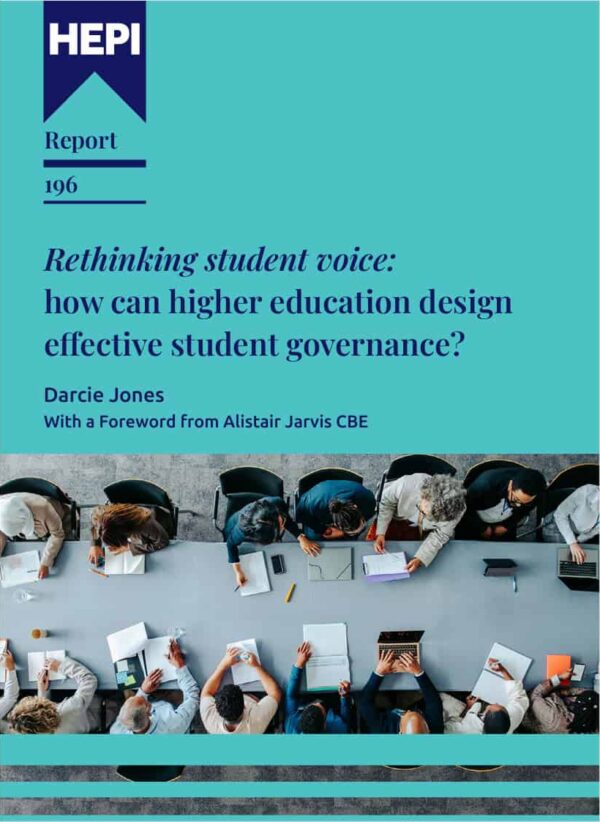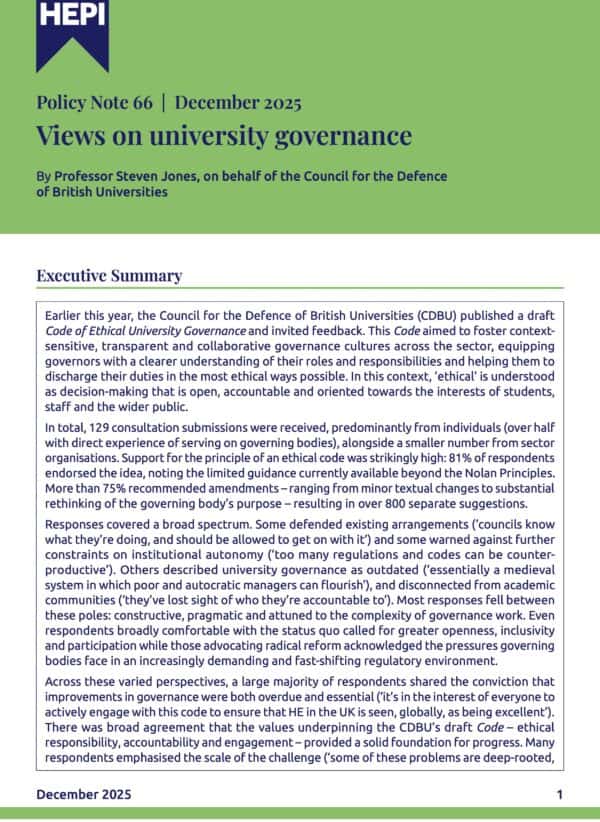Tertiary Collaborations in Practice: what partnerships between colleges and universities actually do and where to go next
UK universities are under mounting financial pressure. Join HEPI and King’s College London Policy Institute on 11 November 2025 at 1pm for a webinar on how universities balance relatively stable but underfunded income streams against higher-margin but volatile sources. Register now. We look forward to seeing you there.
This blog was kindly authored by Josh Patel (@joshpatel.bsky.social), Senior Researcher at the Edge Foundation.
The Prime Minister’s new target is for two-thirds of young people to participate in higher-level learning by age 25. This encompasses not only undergraduate degrees but also higher technical education and apprenticeships, all delivered under a single funding model for all Level 4-6 courses. Some have described this as England’s turn to tertiary, six years after the Augar Review called for a more ‘joined-up system’.
Since at least the 1990s, English post-secondary education has been characterised by market-based regulatory apparatus and fragmentation. Further education is associated with technical and vocational education, and training and entry to the labour market; higher education with professions, leadership, and research. Oversight of both is dispersed across multiple agencies and further disconnected from adult and lifelong learning. Critics have argued that, consequently, market logics have sustained wasteful competition and produced a homogenised system that privileges higher education over further education, to the detriment of equity and national skills needs.
If Augar exposed the limits of market-driven differentiation between further education and higher education, tertiary approaches in the devolved nations illustrate how greater collaboration and integrated oversight offer a potential corrective. Wales and Scotland have advanced considerably in a ‘tertiary’ direction and developed governance modes that exercise holistic stewardship over funding and quality regimes. They are justified on grounds of efficiency, concertedness, and the capacity to advance the common good. In Wales, Medr uses its statutory powers under the Well-being of Future Generations Act to guide institutions in meeting duties on equality, sustainability, and civic mission. In Scotland, the Scottish Funding Council leads the Outcome Agreement process, through which colleges and universities set out activities in return for funding. Even in England, partnerships at a regional level, such as those in the North East or through Institutes of Technology, aim to facilitate partnerships to align lifelong learning with local economic needs. In 2021, the last time a representative survey of the scale of collaboration took place, 80% of colleges and 50% of universities in the UK had formal programme links (and it is likely that collaboration has grown since then).
Despite this prevalence and enthusiasm, research on how the benefits arising from tertiary collaboration manifest at the level of institutions and students is limited. In a short exploratory study with the Edge Foundation, I examined one facet of tertiary systems in Scotland and England: the creation of formal student transition ‘pathways’ between colleges and universities. The aim was not a comprehensive survey, but to sample something of the nature of collaboration in existing systems, to gather evidence to think with and about the concept of tertiary and the place of collaboration and competition.
Collaboration as an adaptive strategy
Existing collaborations are, perhaps surprisingly, not foremost concerned with any given common good. Instead, collaboration often emerges as an adaptive strategy within conditions of resource scarcity. Local ‘natural alliances’ in shared specialisms, mutual values, and commitments to widening participation were important in establishing trust necessary to sustain joint work. Yet, as the study found, institutional precarity is the principal driver.
One Scottish interviewee put it plainly:
‘If I’m sitting there and I’ve got 500 applications, like 10 applications for any place, I’ve got good, strong applications. I’m not going to be going, right, how am I going to look at different ways to bring in students?’
Well-resourced institutions do not collaborate out of necessity: those under pressure do. Partnerships often take the form of a ‘grow your own’ recruitment pipeline, guaranteeing transitions between partner institutions. Universities could ask ‘some tough questions’ of colleges if progression was lower than anticipated. In some cases, institutions agree to partition markets to avoid directly competing for the same students.
Collaboration could also be used as an instrument of competition. In Scotland, articulation agreements (under which universities recognise vocational qualifications such as HNDs and HNCs and admit students with advanced standing) are commonplace. Colleges in this research reported ‘some bad behaviour’ where partner universities would use these agreements to siphon off students from colleges to secure enrolment numbers. This was contrary to the wishes of colleges, which argued that many such students might benefit from the more intimate and supportive college environment for an additional year, better preparing them to enter the more independent learning environment of university.
What collaboration offers students
Where collaboration was stable, tangible benefits followed for learners. Partnerships combine colleges’ attentive pedagogies and flexible resources with university accreditation and facilities. This enables smaller class sizes, greater pastoral attention, and sometimes improved retention and progression, particularly in educational cold spots. Colleges bring local specialisms and staff expertise, often linked to industry, which enrich university courses through co-design and joint delivery.
This lends cautious support to the claims of tertiary advocates: that collaboration can widen access and enhance provision. Yet formal, longitudinal evidence of graduate outcomes remains rare. The value of such partnerships, their distinctiveness, public benefit, and contribution to regional prosperity need to be more readily championed.
From expedient to strategic collaboration
As an instrument, collaboration is worth understanding. The capacity to facilitate collaboration as a strategic good is an important policy lever where market mechanisms are unable to respond immediately or efficiently to the imperatives of national need and public finance. The study suggests four priorities for policymakers:
Clarify national priorities and reform incentives
Collaboration has greater utility than an institutional survival tool. With the bringing together of funding for further education and higher education, there is an opportunity to create stability. Together with the clear articulation of long-term educational goals, strategic cooperation in pursuit of these ends could be sustained.
Strengthen regional governance
Where regional stewardship exists, through articulation hubs or in Scotland’s Outcome Agreements, collaboration is more systematic. England’s existing fragmented oversight and policy churn undermine this. Regional coherence enables institutions to collectively make strategic planning decisions.
Value colleges’ distinct niche
Colleges’ localism, technical capacity, and pedagogical expertise are distinctive assets. Policy should promote these specialisms and encourage co-design and co-delivery rather than hierarchical franchising. Partnerships should foreground each institution’s unique contribution, not replicate the same provision in different guises.
Improve data sharing and evaluation
The absence of mechanisms to track students’ journeys and long-term outcomes, including ‘distance travelled’ evaluations, makes claims about distinctiveness and public benefit harder to substantiate.
Tertiary turns in resource scarcity
Policy discourse has tended to over-dichotomise competition and collaboration. The question is: to what extent each strategy is most helpful for achieving agreed social ends. Where partnership is an appropriate mechanism, it requires a policy architecture with clarity of purpose and stability. To what ends collaboration is put to must be settled through democratic means – a more complicated question altogether.







Comments
Gavin Moodie says:
Thanx for this.
This link is broken:
80% of colleges and 50% of universities in the UK had formal programme links
I think it refers to Shattock, M., & Hunt, S. (2021: 17, 20). Intersectoral relationships within higher education: the FE/HE interface in the UK. Centre for Global Higher Education Working Paper, 70.
https://www.researchcghe.org/publication/intersectoral-relationships-within-higher-education-the-fehe-interface-in-the-uk/
Reply
Jonathan Alltimes says:
I agree there should be more collaboration between colleges and universities, but from the perspective of the student, collaboration is likely to be a long hard road of up to six years or more in duration for technical education and training. Can the new V level technical qualifications, followed by a degree (apprenticeship) be compressed? Not many students, even when prioritised with maintenance grants, could sustain such financial dedication in today’s world.
Reply
Add comment